By Guest Author
Charles Hugh Smith publishes Foreclosure Crisis Weekly, dedicated to
documenting the often-amazing foreclosure crisis.
All attempts to reform the Status Quo of advanced finance-based
Capitalism will fail, as its historically inevitable crisis is finally at
hand.It is self-evident that conventional economics has failed,
completely, utterly and totally. The two competing cargo cults of tax
cuts/trickle-down and borrow-and-spend stimulus coupled with monetary
manipulation have failed to restore advanced Capitalism’s vigor, not just in
America, but everywhere.
Conventional econometrics is clueless about the root causes of
advanced finance-based Capitalism’s ills. To really understand what’s
going on beneath the surface, we must return to “discredited” non-quant models
of economics: for example, Marx’s critique of monopoly/cartel, finance-dominated
advanced Capitalism. (“Capitalism” is capitalized here to distinguish it from
“primitive capitalism.”)
All those fancy equation-based econometrics that supposedly model human
behavior have failed because they are fundamentally and purposefully
superficial: they are incapable of understanding deeper dynamics that don’t fit
the ruling political-economy conventions.
Marx predicted a crisis of advanced Capitalism based on the rising
imbalance of capital and labor in finance-dominated Capitalism. The
basic Marxist context is history, not morality, and so the Marxist critique is
light on blaming the rich for Capitalism’s core ills and heavy on the
inevitability of larger historic forces.
In other words, what’s wrong with advanced Capitalism cannot be fixed by
taxing the super-wealthy at the same rate we self-employed pay (40% basic
Federal rate), though that would certainly be a fair and just step in the right
direction. Advanced Capitalism’s ills run much deeper than superficial “class
warfare” models in which the “solution” is to redistribute wealth from the top
down the pyramid.
This redistributive “socialist” flavor of advanced Capitalism has bought
time–the crisis of the 1930s was staved off for 70 years–but now redistribution
as a saving strategy has reached its limits.
The other political-economic strategy that has been used to stave off
the crisis is consumer credit: as labor’s share of the economy shrank,
the middle class workforce was given massive quantities of credit, based on
their earnings and on the equity of the family home.
The credit model of boosting consumption has also run its
course, though the Keynesian cargo cult is still busily painting radio
dials on rocks and hectoring the Economic Gods to unleash their magic “animal
spirits.”
The third strategy to stave off advanced Capitalism’s crisis was to
greatly expand the workforce to compensate for labor’s dwindling share of the
economy. Simply put, Mom, Aunty and Sis entered the workforce en masse
in the 1970s, and their earning power boosted household income enough to
maintain consumption.
That gambit has run out of steam as the labor force is now shrinking for
structural reasons. Though the system is eager to put Grandpa to work as a
Wal-Mart greeter and Grandma to work as a retail clerk, the total number of jobs
is declining, and so older workers are simply displacing younger workers. The
gambit of expanding the workforce to keep finance-based Capitalism going has
entered the final end-game. Moving the pawns of tax rates and fiscal stimulus
around may be distracting, but neither will fix advanced finance-based
Capitalism’s basic ills.
The fourth and final strategy was to exploit speculation’s ability to
create phantom wealth. By unleashing the dogs of speculation via a vast
expansion of credit, leverage and proxies for actual capital, i.e. derivatives,
advanced finance-based Capitalism enabled the expansion of serial speculative
bubbles, each of whcih created the illusion of systemically rising wealth, and
each of which led to a rise in consumption as the “winners” in the speculative
game spent some of their gains.
This strategy has also run its course, as the public at last grasps that
bubbles must burst and the aftermath damages everyone, not just those who
gambled and lost.
Two other essential conditions have also peaked: cheap energy and
globalization, which opened vast new markets for both cheap labor and new
consumption. As inflation explodes in China and its speculative credit-based
bubbles burst, and as oil exporters increasingly consume their resources
domestically, those drivers are now reversing.
Advanced Capitalism is broken for reasons conventional economics
cannot dare recognize, because it would spell the end of its intellectual
dominance and the end of the entire post-war political-economic paradigm that
feeds it.
Let’s look at some charts to see what conventional economists must
deny to keep their jobs.
Take a look at this chart. What reality does it reflect? A failure to cut
taxes enough? A failure to print enough money or extend enough credit? No.
What it reflects is labor’s dwindling share of the economy.
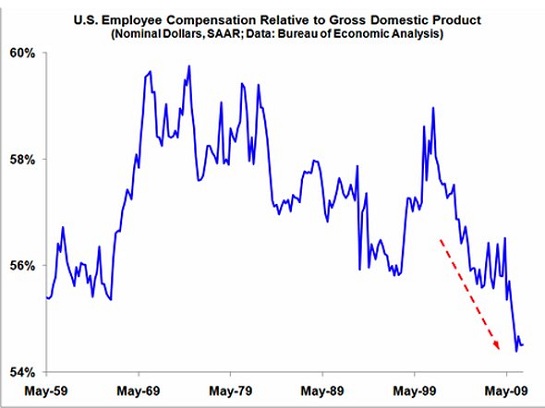
The structural reality is that employment is declining:
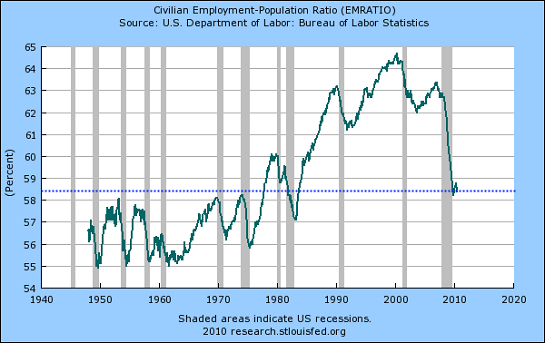
Meanwhile, after-tax corporate profits have steadily climbed to nearly 10% of
the entire national income:
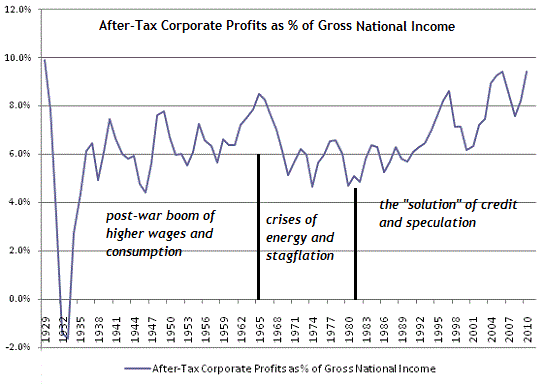
Note the recent rise of finance-based profits:
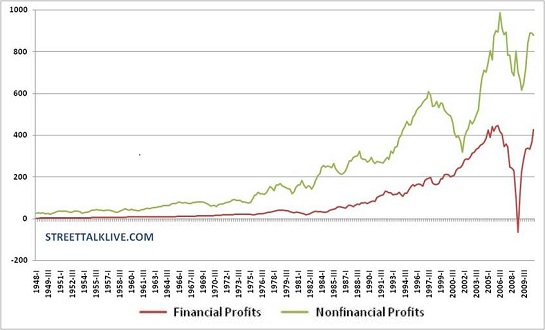
This chart leaves no doubt that the engines of the past 30 years “growth” and
“prosperity” have been credit and credit-fueled speculation:
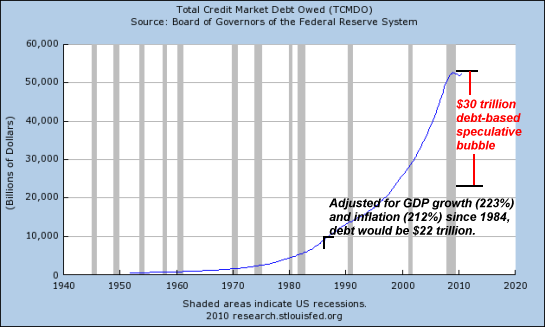
If we look at disposable income, we find that direct government transfers
have masked the systemic erosion of labor’s earnings and employment:
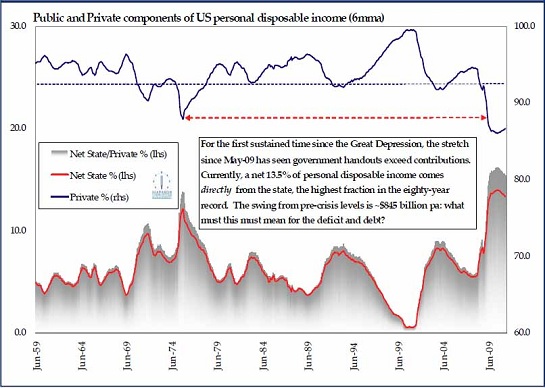
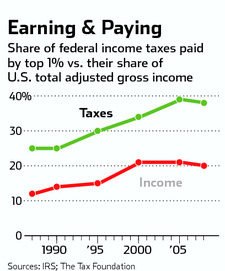
By at least some measures, the top 1% are paying a greater share of total taxes than they were 20 years ago, which suggests that “tax the rich will solve everything” stopgaps have limited purchase on the deeper structural ills of advanced finance-based Capitalism.
Marx identified two critical drivers of advanced Capitalism’s final
crisis:
1. Global Capital has the means and incentive to keep labor in surplus and
capital scarce, which means that capital has pricing power and labor has none.
The inevitable result of this is that wages, as measured in purchasing power,
fall while the returns earned on capital rise.
This establishes a self-reinforcing, inevitably destructive
dynamic: once labor’s share of the national income falls below a
critical threshold, labor can no longer consume enough or borrow enough to keep
the economy afloat with its cash and credit-based consumption.
We are at that point, but massive Federal borrowing and transfers are masking
that reality for the time being.
2. The dual forces of competition and technology inevitably drive down the
labor component of all manufactured goods and technology-based services.
Mechanization, robotics and software have lowered the labor component of
everything from running shoes to computer chips from $20 per item to $2 per
item, and that process cannot be reversed. While the wage paid to the workforce
designing and manufacturing the products and providing the services may actually
rise, the slice of revenues given over to all labor continues shrinking.
This is what I have constantly referred to (using Jeremy Rifkin’s excellent
phrase) as “the end of work.”
Put another way: the return on capital invested in techology greatly exceeds
the return on labor. Industries and enterprises which fail to leverage capital
invested in technology that lowers the labor component of their good/service
eventually undergo rapid and inevitable creative destruction.
We are about to witness this creative destruction in the labor-heavy
industries of government, education and healthcare.
Marx’s genius was to recognize the historical inevitability of these
internal forces within advanced Capitalism. He also recognized the
inevitability of finance-capital’s dominance of industrial capital–something we
have witnessed in full flower over the past 30 years.
Finance capital now dominates not just industrial capital but the machinery
of governance, rendering real reform impossible. Instead, the Status Quo
delivers up simulacrum “reform” which change nothing but the packaging of the
Central State/Cartel Capitalism’s exploitation and predation.
Add all this up and you have to conclude the final crisis of
finance-based advanced Capitalism is finally at hand. All the “fixes” that
extended its run over the past 70 years have run their course. Life
will go on, of course, after the Status Quo devolves, and in my view, ridding
the globe of financial predation and parasitism will be a positive step
forward.
The real solution is to understand advanced finance-based global Capitalism
will unravel as a result of the internal dynamics described above, and be
replaced with an economic and political Localism that I describe in my new book
An Unconventional Guide to Investing in Troubled Times.I don’t
claim these ideas are unique to me; many others have described the same dynamics
and historical trends.
No comments:
Post a Comment